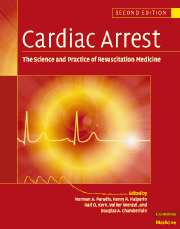Book contents
- Frontmatter
- Contents
- List of contributors
- Foreword
- Preface
- Part I Introduction
- Part II Basic science
- Part III The pathophysiology of global ischemia and reperfusion
- Part IV Therapy of sudden death
- Part V Postresuscitation disease and its care
- Part VI Special resuscitation circumstances
- 52 Prevention of sudden death in patients at risk: channelopathies and arrhythmic syndromes in the structurally normal heart
- 53 Pediatric cardiopulmonary resuscitation
- 54 Resuscitation in elder persons
- 55 Asphyxial cardiac arrest
- 56 Hemorrhagic shock and hypovolemic cardiac arrest
- 57 Cardiopulmonary resuscitation in hypothermic patients
- 58 Cardiac arrest due to poisoning
- 59 Cardiac arrest during anesthesia
- 60 Resuscitation of the pregnant patient suffering sudden cardiac death
- 61 Drowning
- 62 Anaphylactic shock
- 63 High altitude resuscitation
- 64 Electrical injuries
- 65 Rare syndromes, commotio cordis, sudden death in athletes
- Part VII Special issues in resuscitation
- Index
59 - Cardiac arrest during anesthesia
from Part VI - Special resuscitation circumstances
Published online by Cambridge University Press: 06 January 2010
- Frontmatter
- Contents
- List of contributors
- Foreword
- Preface
- Part I Introduction
- Part II Basic science
- Part III The pathophysiology of global ischemia and reperfusion
- Part IV Therapy of sudden death
- Part V Postresuscitation disease and its care
- Part VI Special resuscitation circumstances
- 52 Prevention of sudden death in patients at risk: channelopathies and arrhythmic syndromes in the structurally normal heart
- 53 Pediatric cardiopulmonary resuscitation
- 54 Resuscitation in elder persons
- 55 Asphyxial cardiac arrest
- 56 Hemorrhagic shock and hypovolemic cardiac arrest
- 57 Cardiopulmonary resuscitation in hypothermic patients
- 58 Cardiac arrest due to poisoning
- 59 Cardiac arrest during anesthesia
- 60 Resuscitation of the pregnant patient suffering sudden cardiac death
- 61 Drowning
- 62 Anaphylactic shock
- 63 High altitude resuscitation
- 64 Electrical injuries
- 65 Rare syndromes, commotio cordis, sudden death in athletes
- Part VII Special issues in resuscitation
- Index
Summary
Introduction
Without the inherent risk of cardiac arrest (CA), anesthesia might not have developed as an acknowledged medical specialty in its own right. Only a year after painless surgery was made possible in 1846 by W.T.G. Morton 's use of ether as an anesthetic, cases of death under inhalation anesthesia occurred in England. In 1848, Hannah Green, a young healthy patient undergoing a trivial procedure for removal of an infected toenail, became the first reported fatality from chloroform anesthesia and, even today, her name stands for every anesthesiologist 's nightmare.
John Snow, whose work on resuscitation is less well known than his contributions to the scientific foundations of anesthesia for infants, had by 1841 accumulated considerable expertise in the field of resuscitating asphyxiated stillborns. With his monograph On Chloroform and Other Anaesthetics published in 1858, John Snow became the world 's first scientific anesthesiologist, and with his review of 50 cases of fatal chloroform administration he also became the first researcher on the mechanism of critical incidents and the first promoter of modern resuscitation medicine. Some of his recommended techniques of resuscitation included use of the “tracheal tube,” administration of oxygen, mouth-tomouth or mouth-to-nostril ventilation, compression of the ribs and abdomen, and introduction of galvanic current. Thus, CA strongly influenced the professionalization of anesthetic practice, while at the same time anesthesia offered the hitherto unknown opportunity for investigating and treating a multitude of expected, observed, and, later on, monitored and instrumented cases of CA that have facilitated the successes in modern resuscitation medicine during the last 150 years.
- Type
- Chapter
- Information
- Cardiac ArrestThe Science and Practice of Resuscitation Medicine, pp. 1043 - 1075Publisher: Cambridge University PressPrint publication year: 2007



